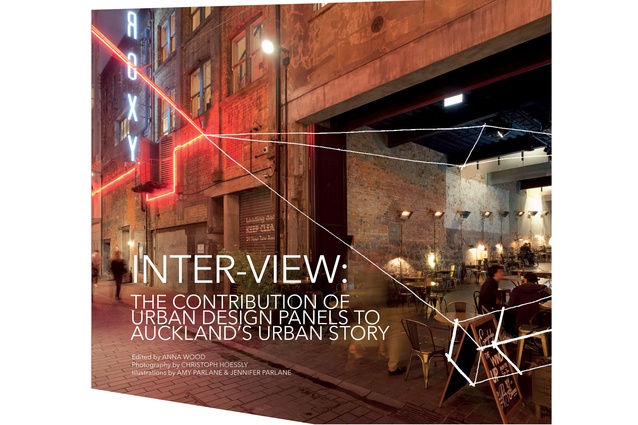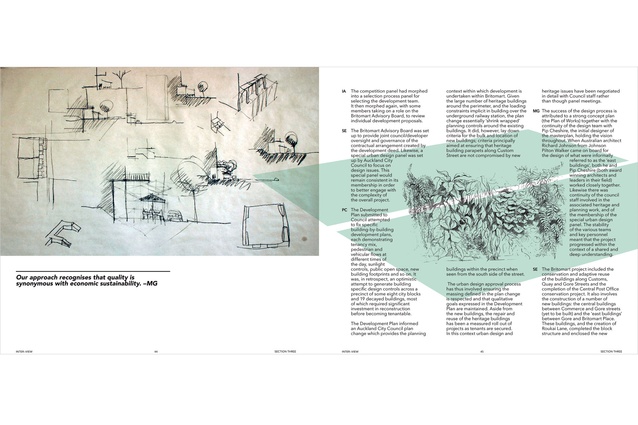Book review: Inter-view: The Contribution of Urban Design Panels to Auckland’s Urban Story
Success has many authors, it is said, except apparently in Auckland where the Council’s Urban Design Panel is responsible for all that is good – or, at least, this is what this publication would have us believe. The Urban Design Panel has, in fact, done a great deal of good work over the last decade and has been one of the best tools for improving the design quality of both buildings and urban spaces in the country’s largest city. But this is a review of the book, not the panel.
The Urban Design Panel deserves an objective book, symposium or review that would critically look at its work over the last several years, contrast it with similar groups in other cities and identify strengths and areas for improvement. This would assist both the panel and the outcomes of the urban design process in Auckland, as well as being of use to other conurbations and councils which are in similar positions to ours. But, unfortunately, this book, effectively self-published by Auckland City, is an addition to that 21st-century genre of hagiographic publications sponsored by architectural firms and others that show off their work and, basically, come close to being mere public relations material.
The book is focused on 10 large developments that are generally success stories – it would have been of benefit to have canvassed other buildings or precincts without such good outcomes and seen what could have been improved there. Within these 10 sections, the text is structured lazily as a conversation, usually between an urban design panellist, an architect, a Council officer and a developer, all of whom were complicit in the process. These conversations are largely self-congratulatory with everyone agreeing on what a good process the whole thing was and what a good job the panel and Council have done. Well, you would, wouldn’t you? In my experience of reviewing many Auckland projects over the last decade, architects, largely, have found the panels to be very useful, as one is dealing, in many ways, with critique by one’s peers. Also, the panels’ comments can provide useful leverage in the constant battle with client or project manager value management. But franker conversations or critical essays would do us all better here.
One example is the Waterview Connection project, “arguably the most important project to be reviewed by the Auckland Urban Design Panel” (and one in which I should admit to professional and personal involvement). The panel’s role was to assist Auckland Council in its submission during the Board of Inquiry process so, when a panel member says that the panel’s “comments provided comfort to the community”, that is to assume that the Council’s goals were aligned with those of the wider community. That wasn’t the case and much of the improved design outcome from the entire consenting process was as a result of the community, the Local Board and their respective experts battling it out in the Board of Inquiry with the New Zealand Transport Agency and its fellow travellers, such as the Auckland Council. And the same remains the case with many Auckland urban design issues and that is why a book such as this would be much more useful if it took a wider and more critical view of the last 10 years it covers. There is no doubt there have been vast improvements in Auckland but there remain many unfortunate outcomes as well that haven’t been focused on here.
In other sections, there are some brief essays. Those by Council officers are what you would expect: full of buzzwords about aspirations, principles, outcomes and goals. Those by a couple of “international experts” are in the nature of the kind of hopeful-in-tone forewords that we often see in books of this nature. Only that by academic John Hunt comes close to being usefully objective and constructive in identifying how Auckland’s current panel differs from those elsewhere and offering views on what needs to be done to improve processes.
Where’s the voice of the public and other outsiders (sorry, ‘stakeholders’) amid all this mutual back-patting? There are some little vox pop-like quotes from the public sprinkled about but these have been carefully solicited. In the Waterview case, there is a quote from a businessman (sorry, ‘social entrepreneur’) who set up a coffee cart in the area, “which became a meeting point for the community and the development staff, along with the only place in Waterview where you can get a decent cup of coffee”. So Waterview loses 60 houses to a motorway, the school roll is slashed and its buildings are demolished, but at least you can get “a decent cup of coffee”? Well, I suppose that’s a reflection of Auckland values.
Auckland’s Urban Design Panels deserve better than this self-congratulatory publication; file it under self-serving public relations material and another lost opportunity for interrogative history and constructive critique.











